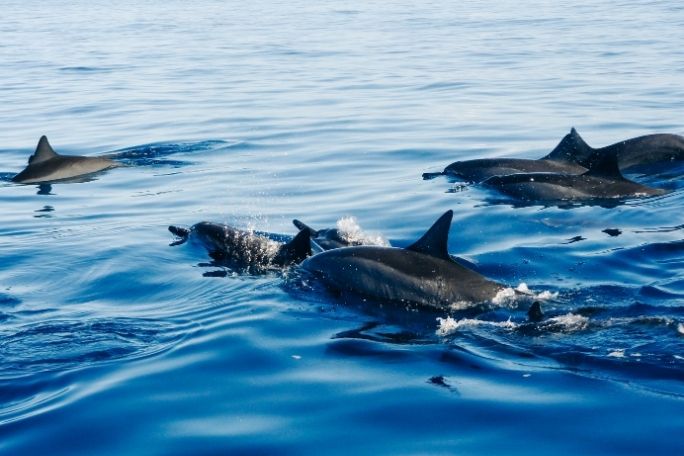Lesson summary
Students reflect on their understanding of human impacts on the ocean and think about their dreams for the ocean. They begin by reviewing prior knowledge on how we need and impact the ocean, before exploring and analysing some of the dreams other people have for the ocean. They use these ideas as inspiration to create their own dream statements about the ocean. Working independently students will use their dream statements as the basis for an artwork. Students will have the opportunity to exhibit their artwork to an audience.
Learning intentions:
Students will...
- understand that we can all take action to reduce the impact of plastic waste on our oceans
- identify and articulate their dreams for the oceans
- will develop and practise art-making techniques
Success criteria:
Students can...
- think critically about the dream statements of themselves and others
- plan and create artworks
- use different drawing/painting techniques
- engage in group and class discussions
Lesson guides and printables
Curriculum links
Select your curriculum from the options below.
Lesson details
Curriculum mapping
Australian curriculum content descriptions:
Depending on the activities you choose, you may meet the following content descriptions:
Year 4 English:
- Reread and edit for meaning by adding, deleting or moving words or word groups to improve content and structure (ACELY1695)
- Plan, draft and publish imaginative, informative and persuasive texts containing key information and supporting details for a widening range of audiences, demonstrating increasing control over text structures and language features (ACELY1694)
Year 5 English:
- Plan, draft and publish imaginative, informative and persuasive print and multimodal texts, choosing text structures, language features, images and sound appropriate to purpose and audience (ACELY1704)
- Reread and edit student’s own and others’ work using agreed criteria for text structures and language features (ACELY1705)
Year 6 English:
- Analyse and evaluate similarities and differences in texts on similar topics, themes or plots (ACELT1614)
- Plan, draft and publish imaginative, informative and persuasive texts, choosing and experimenting with text structures, language features, images and digital resources appropriate to purpose and audience (ACELY1714)
- Reread and edit students’ own and others’ work using agreed criteria and explaining editing choices (ACELY1715)
Year 4 Visual Arts:
- Use materials, techniques and processes to explore visual conventions when making artworks (ACAVAM111)
- Present artworks and describe how they have used visual conventions to represent their ideas (ACAVAM112)
Years 5 & 6 Visual Arts:
- Develop and apply techniques and processes when making their artworks (ACAVAM115)
- Plan the display of artworks to enhance their meaning for an audience (ACAVAM116)
Syllabus outcomes: EN2-2A, EN3-2A, EN3-7C, VAS2.1, VAS2.2, VAS3.1, VAS3.2
General capabilities: Critical and Creative Thinking, Literacy
Cross-curriculum priority: Sustainability (OI.6)
Relevant parts of Year 4 English achievement standards: Students create structured texts to explain ideas for different audiences. They reread and edit their work to improve meaning.
Relevant parts of Year 5 English achievement standards: Students create imaginative, informative and persuasive texts for different purposes and audiences. They edit their work for cohesive structure and meaning.
Relevant parts of Year 6 English achievement standards: Students create detailed texts elaborating on key ideas for a range of purposes and audiences.
Relevant parts of Year 4 Visual Arts achievement standards: Students use visual conventions, techniques and processes to communicate their ideas.
Relevant parts of Year 5 & 6 Visual Arts achievement standards: Students use visual conventions and visual arts practices to express a personal view in their artworks. They demonstrate different techniques and processes in planning and making artworks. They describe how the display of artworks enhances meaning for an audience.
This lesson is part of the wider unit of work Take 3 For The Sea – Project-based Learning – Years 4 to 6
Time required: 160+ mins
Level of teacher scaffolding: Medium – lead students in class discussion, oversee art-making and exhibition activities
Resources required
- Art-making materials
- Device capable of presenting a website and video to the class
- Student Worksheet – one copy per student
Skills
This lesson is designed to build students’ competencies in the following skills:
- Communication
- Critical thinking
- Creativity
Additional info
Take 3 is an Australian charity removing rubbish from the environment through education programs, international campaigns and clean-ups. Take 3’s call to action is simple: Take 3 pieces of rubbish with you when you leave the beach, waterway or… anywhere and you have made a difference.


Welcome back!
Don't have an account yet?
Log in with:
Create your free Cool.org account.
Many of our resources are free, with an option to upgrade to Cool+ for premium content.
Already have an account?
Sign up with:
By signing up you accept Cool.org's Terms and Conditions(Opens in new tab) and Privacy Policy(Opens in new tab).